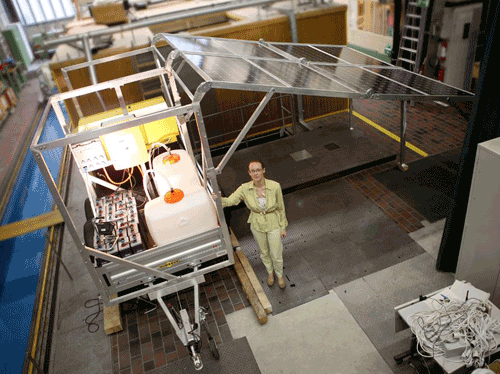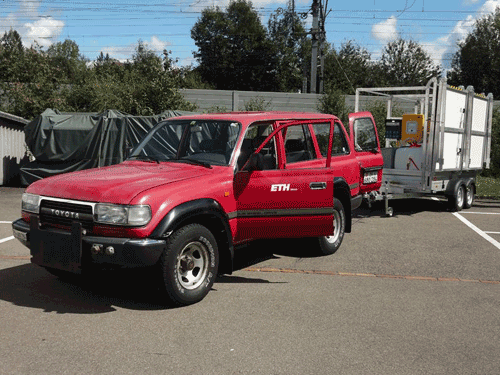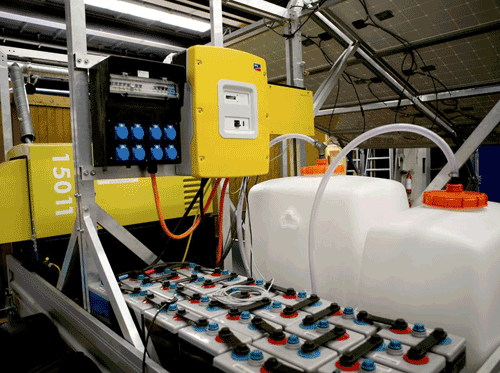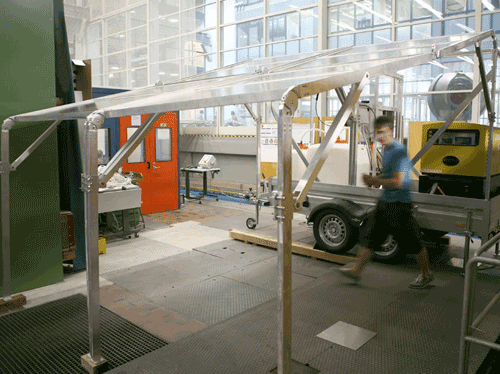Completely portable hybrid power generator also purifies water
Students create intelligent generator for use in developing countries
Citing studies that point to a strong correlation between electricity supply and quality of life, Anna Gawlikowska, a postdoc at the Institute of Energy Technology, together with Professor Reza S. Abhari, advised a Master’s project at the Department of Mechanical and Process Engineering to design an intelligent generator for developing countries.

Postdoc Anna Gawlikowska with her group’s intelligent generator: the Smart Micro Grid System.
Student John Oldridge was drawn to the idea of creating something that could benefit those in need, so he, along with fellow student Till Richter, spent time researching preliminary studies conducted by other students at ETH Zurich and the University of St. Gallen.
They came to the conclusion that the biggest reasons why mobile power generators haven’t taken off yet are that they’re too expensive or otherwise still in a research phase.
So Oldridge and Richter set out to create a new path. Their goals were simple: create an electric generator cheap enough to use in developing countries, robust enough that it could support multiple households, and simple enough that it could be used by anyone.
Lots of energy
The project took six months to develop, but they were eventually able to showcase a prototype model called the “Smart Micro Grid System.”

The Smart Micro Grid System is a cost-effective, efficient, and completely portable way to provide power to impoverished areas of the world.
It’s an all-in-one power supply system compact enough to fit onto a trailer. The focus of it is around a diesel generator that produces enough power to supply up to 100 people in 20 houses with 15 kilowatts of electricity daily.
Yes, that doesn’t sound like much, but for those in poorer areas of the world, who otherwise do not have access to grids or other power supplies, it’s enough to power a hotplate, lamps, small television, and a refrigerator.
To optimize the power being generated, Oldridge and Richter hooked up a battery to the system to store extra electricity. Doing this allowed the generator to run continuously at peak performance for longer periods of time and also rest during times when demand for electricity was lower. This, it turns out, enabled the conversion of energy from fuel to electricity to increase a whopping 60%.

The Smart Micro Grid System includes batteries to store extra power for future use.
They didn’t stop there
Along with the generator, the system also includes eight solar cells that produce about 10% of the total output.

The Smart Micro Grid System’s solar cells provide 10% of the system’s total power.
The cells, as you can see, don’t take up much space. That’s because of the team’s ingenious idea of having them fold up on the sides of the trailer.
Now granted, there are other forms of renewable power technology out there that could be added to the system, but including them not only increased the cost significantly, it also forfeited its overall compactness.
For those two reasons, the group opted to forego the extra technology.
Thermal energy=purified water
Along with producing power, the Micro Grid System also uses wasted heat to kill off pathogenic germs in contaminated water. There are two reasons why this is a great idea: (1) The water needs to only be heated above 169F (76-C) in order to do this and (2) The heat generated by the system accounts for roughly two-thirds of the system’s total energy — no sense in letting it go to waste.
When the system is running at full capacity, it can purify up to 1,000 liters of water per day, a tremendous opportunity for residents who otherwise do not have regular access to clean drinking water.
Central command
Now, with one system offering so many different functions and capabilities, there needs to be an easy way to control everything, especially when it comes to determining which houses get how much power. This was addressed by Oldridge and Richter and their solution was to control everything centrally with one main computer.
During the hours of peak usage, when everyone is in their homes with their lights on, cooking up meals and maybe watching some TV, an automatic warning system will let the central controller know that a lot of power is being used. This, in turn, ensures that the system will not become overloaded, as power output can be adjusted accordingly.
Having a main control center also allows for the electricity consumption of each house to be calculated exactly, a prerequisite when introducing the new System as part of the local economic cycle. This feature is helpful when it comes to paying for the power, too: the group envisions a sort of credit-card system, if you will, kind of like prepaid mobile phones. Users would be able to buy electricity credits, maybe in the form of a code-on-voucher, which they could then redeem to activate power in their homes.
Outlook
The water treatment module is presently being improved for a wider range of water quality. Meanwhile, Professor Gawlikowska is looking into funding opportunities to produce 10 Smart Micro Grid Systems. If and when this happens, each system will then be put to the acid test in the countries to which they’re assigned. ■
Via: ethlife.ethz.ch
Advertisement
Learn more about Electronic Products Magazine






